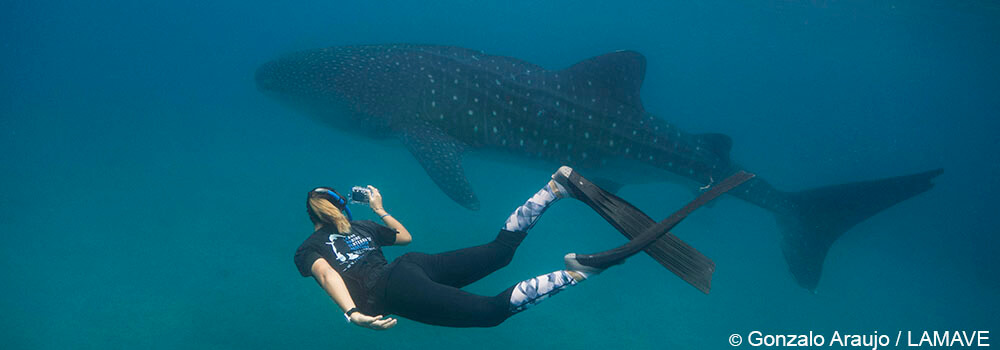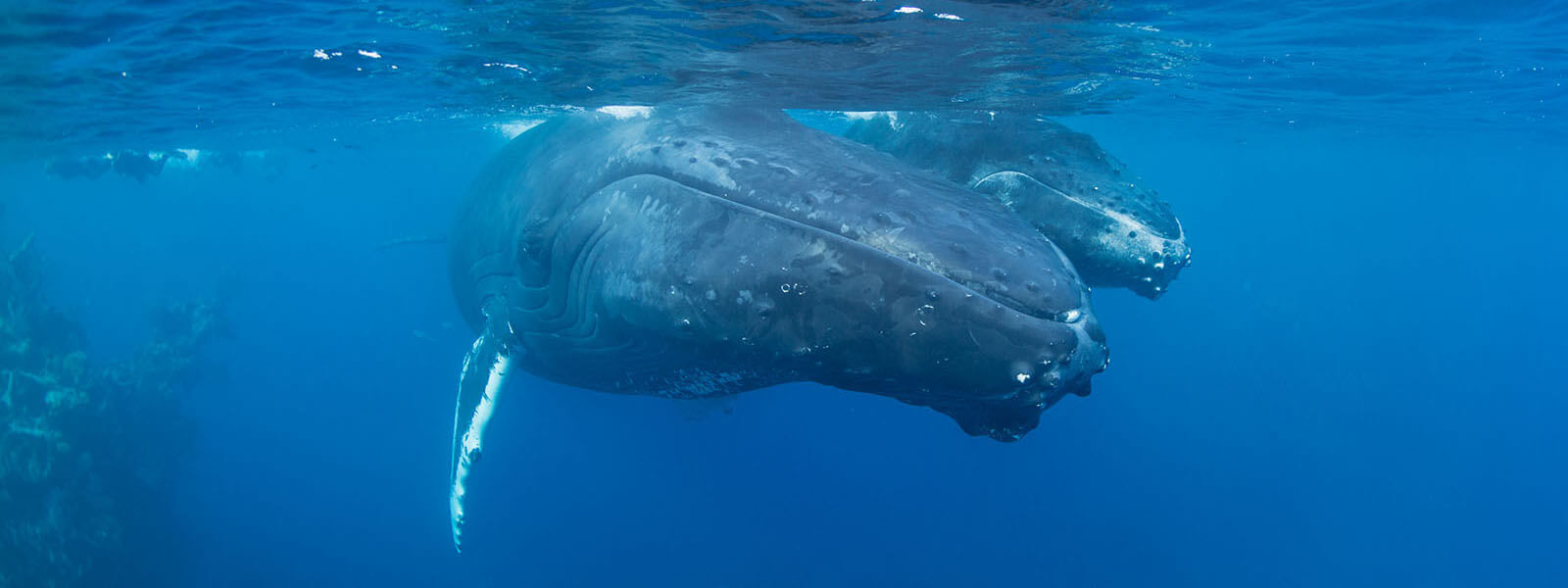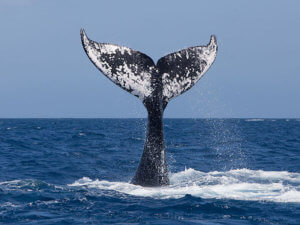Snorkeling with Humpback Whales on the Silver Banks, Dominican Republic
 Scientifically named for their incredibly long pectoral fins and one of the regions they congregate, humpback whales, Megaptera novaengliae (giant-winged New Englander), are undeniably one of the planet’s largest and most majestic creatures. While they range all over the world and typically migrate thousands of miles each year, there are several genetically distinct populations and the North Atlantic humpbacks are visibly divergent in their morphological features, feeding behaviors, as well as their song. Generally known for their exceedingly acrobatic breaching and other surface behaviors, these gentle, baleen giants, which can reach sizes of over 50-feet in length, also exhibit one of the most complex and fascinating vocalizations known in nature.
Scientifically named for their incredibly long pectoral fins and one of the regions they congregate, humpback whales, Megaptera novaengliae (giant-winged New Englander), are undeniably one of the planet’s largest and most majestic creatures. While they range all over the world and typically migrate thousands of miles each year, there are several genetically distinct populations and the North Atlantic humpbacks are visibly divergent in their morphological features, feeding behaviors, as well as their song. Generally known for their exceedingly acrobatic breaching and other surface behaviors, these gentle, baleen giants, which can reach sizes of over 50-feet in length, also exhibit one of the most complex and fascinating vocalizations known in nature.
Our humpback whale encounters take place on the Silver Bank, Dominican Republic. Lying southeast of the Turks & Caicos Islands and about 70 miles north of the Dominican Republic, the Silver Bank is a shallow but mostly submerged reef platform surrounded by deep oceanic waters. Covering over 600 square miles in the Atlantic Ocean, the Silver Bank is named for the treasure spilled from the wreck of the Nuestra Senora de la Concepcion that went down in 1641 while trying to navigate through this perilous reef system.
Patch reefs sporadically rise from the floor of the bank providing a relatively calm area for Humpback mothers and calves. It is thought that most of the humpbacks found in the North Atlantic migrate from the plankton-rich waters off New England and eastern Canada to the Silver Bank each winter. The entire Silver Bank is a now a Dominican Republic Marine Mammal Sanctuary that encompasses the calving and breeding grounds for a majority of the Atlantic humpback whale population. During winter months no vessel is allowed to visit the area without a permit and our vessel has one of only three such permits. Please join us for the incredible opportunity to snorkel with humpback whales!
ITINERARY
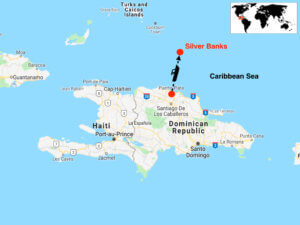 Our 8-day snorkeling adventure to the Silver Bank begins and ends in Puerto Plata, Dominican Republic. We depart from the coastal area of Cofresi for the Silver Bank, taking about 10 hours to reach our destination located about 80 miles from the coast.
Our 8-day snorkeling adventure to the Silver Bank begins and ends in Puerto Plata, Dominican Republic. We depart from the coastal area of Cofresi for the Silver Bank, taking about 10 hours to reach our destination located about 80 miles from the coast.
Day 1: Puerto Plata, Dominican Republic
Meals provided: D
Arrive in Puerto Plata and transfer on your own to the resort beach community of Cofresi where we will meet at the Ocean World Marina at 5:00 pm. We depart for the Silver Bank after our orientation and welcome dinner.
Day 2 – 6: Silver Bank / Humpback Whales
Meals provided: B,L,D
Our next five full days will be spent snorkeling with humpback whales and having the chance to watch them breach and interact from our comfortable skiff.
Day 7: Cofresi / Puerto Plata / International Departures
Meals provided: B
After breakfast we disembark from the boat where we have the chance to ride the Teleferico Puerto Plata Cable Car tour. Located on the top of Mount Isabel (elevation 2500 ft.) the classic cable car affords incredible views of Puerto Plata and nearby environs. Transfers to the airport are included with this tour (most flights depart Dominican Republic in the afternoon). For those with earlier flights, we will arrange transfers from the boat directly to the airport (via taxi).
DEPARTURES
March, 2026←Click to request a booking
Accommodations:
Guides: Lee Goldman, Ethan Daniels
Length: 7 days
Prices and Payment schedule:
$ USD per person, double occupancy
Due to the limited space on the boat, we are dedicating each cabin as either double or twin share. We would be happy to find roommates for single guests who are interested.
Reservation deposit:
Tour cost includes:
- Accommodations on day 1 through day 7
- All meals on days 2 through 6 (dinner on day 1 – breakfast on day 7)
- All internal transfers including international arrival and departure transfers
- Non-alcoholic beverages
- All snorkeling and park fees*
- All gratuities*
*Please note that our price is inclusive of these items where other operators usually promote them as additional costs to their base price (park fees for 2026 = $TBD USD pp / gratuities = $TBD pp)!
Tour cost does not include:
- Round-trip international airfare
- Additional hotel accommodations and meals as a result of travel outside of the program dates
- Visa requirements including payments
- Alcoholic beverages
- International departure taxes
- Extra / overweight baggage fees
- Trip insurance (recommended; (we recommend Travel Guard, World Nomads, or Travel Insure)
- DAN insurance (required unless personal insurance program has worldwide emergency evacuation services)
- Additional accommodations while on tour in the event of flight schedule changes or events of force majeure
- Fuel surcharges (if applicable)
Cancellation policy:
180 – 91 days prior to departure: 50% of trip cost
90 days or less prior to departure: 100% of tour cost
Please see our Terms and Conditions
ACCOMMODATIONS
TBD
WHAT TO EXPECT
The Silver Bank is located between the Dominican Republic and the Turks and Caicos in the tropical Caribbean Sea. Air temperatures hover around 82º F (28º C) with the occasional shower here and there. Water temperatures generally hover around 78º F (26º C), though temperatures may vary on either side by a degree or two.
Due to the nature of this specific snorkeling activity, our snorkeling days will depart from our usual daily schedule. While we plan to spend as much time in the water as possible, it is largely the whales that will dictate our snorkeling times. Encounters can last for minutes up to hours and can occur at any time during the day. As such, we ask everyone to have a fair bit of flexibility and be prepared to snorkel at any moment (yes, even during lunch :-).
WHAT TO BRING
The following list is a suggestion of things to bring and applies to almost all our trips. Specific items on a particular departure will be noted on the departure information.
-A good fitting mask, snorkel, and set of fins. If your equipment is brand new, please try it out in the pool. Determining the fit and function of your equipment in the pool includes doing several laps with all your equipment on. Doing several snorkel dives is also very beneficial. It is also important to clean your new equipment, especially your mask. Cleaning procedures for your mask include light scrubbing with toothpaste or dishwasher soap to remove the layer of silicon used to preserve the mask during shipping. Clean both sides of the mask. Doing this greatly reduces the chances of having your mask fog. Not doing this, even when using mask de-fogger, usually results in a fogged mask.
-A wetsuit, rash guard, diveskin, or any type of clothing that can be used for thermal and/or protection from the sun. We suggest bringing a full 3mm wetsuit and some type of core insulation like a vest or shirt made of 1 – 2 mm neoprene (e.g., Lavacore or Sharkskin shirts or vests). These items will not only provide thermal protection but protection from the sun as well. For those who feel that a 3mm suit may be too warm, please consider a full body skin or rash guard to ensure protection from the sun. With regards to thermal protection, remember the saying: It is better to have and not need, than to need and not have. One that note…
-Head protection in the form of a wetsuit hood, a cap, or even a bandana. Anything that can keep the sun off your head is extremely important. It is the most exposed part of our bodies when we are floating on the surface.
-Underwater flashlight on departures with a planned night snorkel
-Biodegradable sunscreen lotion. Sunscreen lotions can be harmful and even kill tiny larvae (baby marine life). It is fine to wear on land, but we highly discourage the use of sunscreen lotions in the water. A full wetsuit or dive skin will protect one from the sun much better than lotions and provide thermal protection. It is truly a win-win for everyone and the marine environment.
-Casual, lightweight, tropical clothing
-Sunglasses (and a spare in case you lose your main pair)
-Comfortable footwear such as active sandals (Teva, Keen, Merrell, etc.)
-Hats. We cannot stress the importance of a hat in the tropics!
-All our boats provide items like shampoo, soap, towels, etc. We bring this up because these items represent added weight or may leak.
Other items to consider:
-Lightweight rainwear to protect from the occasional afternoon shower
-Binoculars
TRIP REPORTS

Raja Ampat, November 2022 Trip Report

Alor, Indonesia Oct 2022 Trip Report
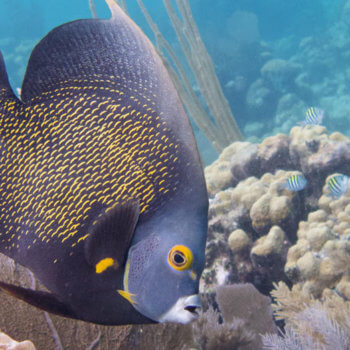
Belize Trip Report, October 2021
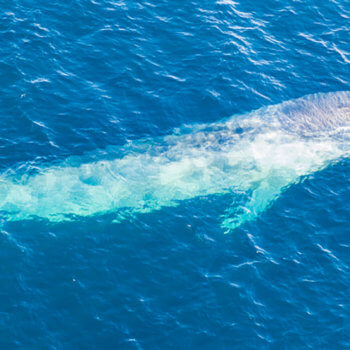
Heart of the Coral Triangle Trip Report
